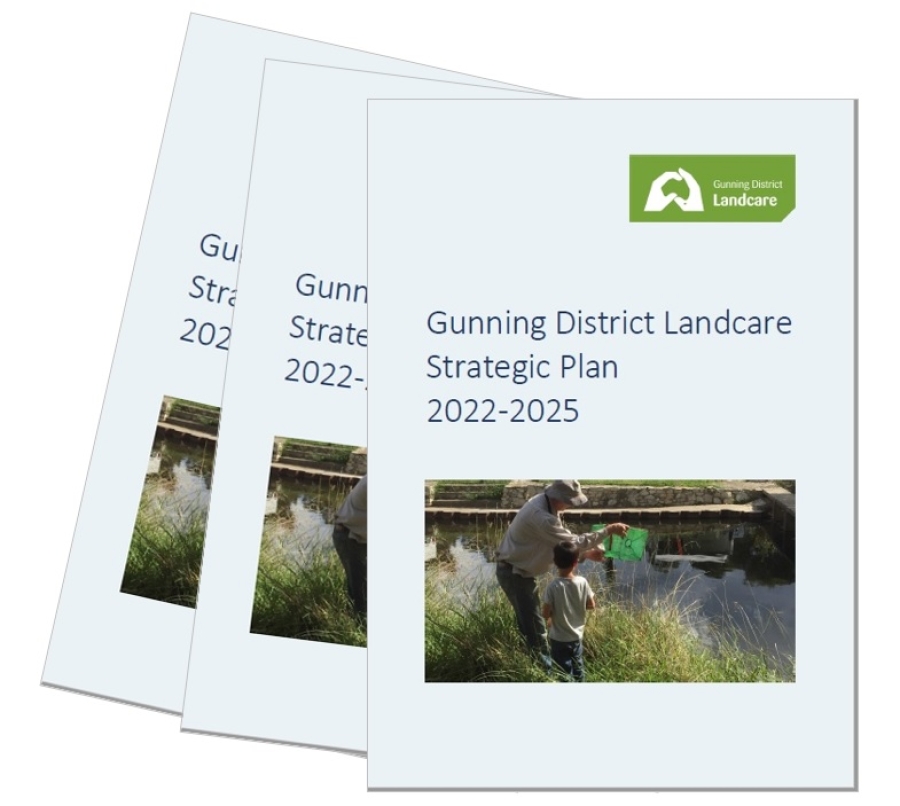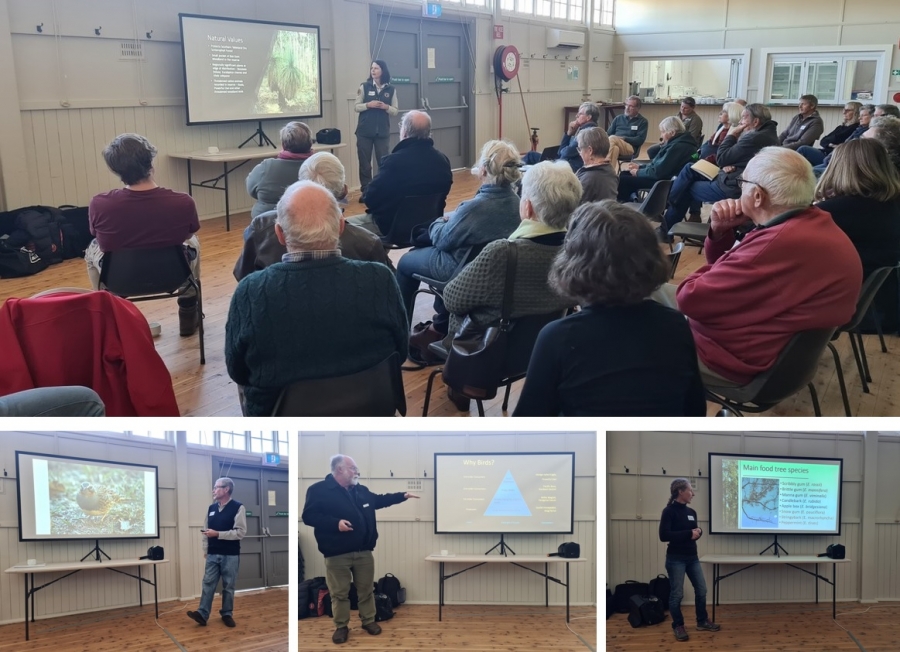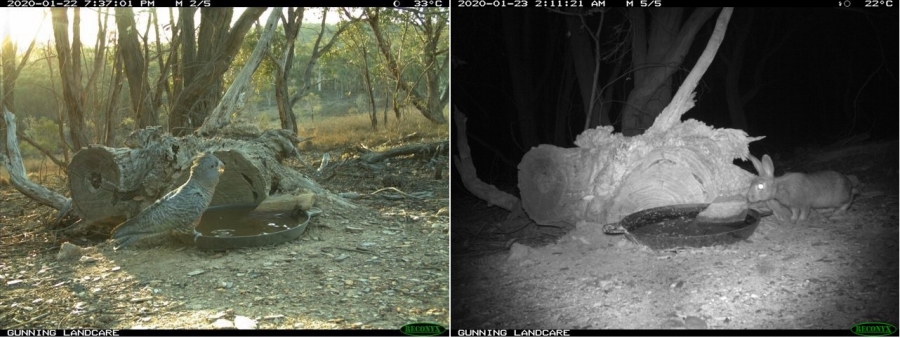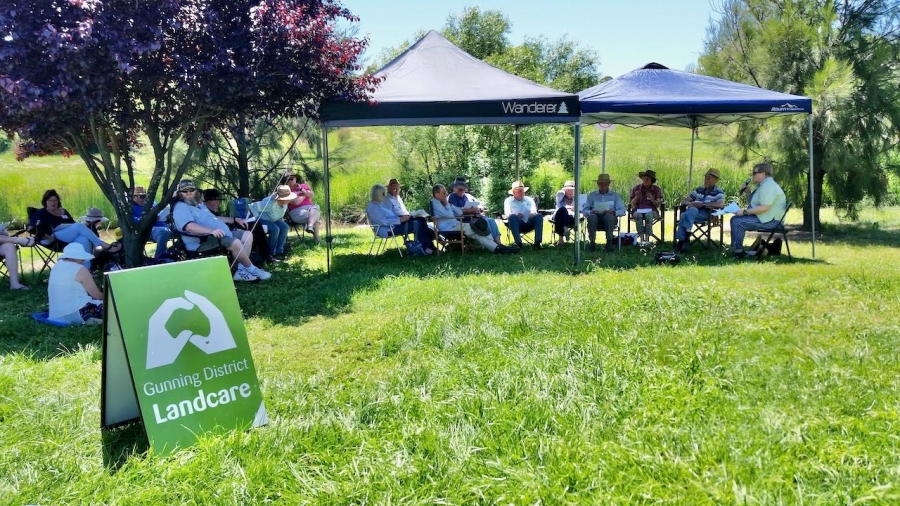Strategically planning for 2022-2025
Gunning District Landcare has recently reviewed and updated our strategic plan through to 2025. You can check out the document here.
The GDL committee reviewed and updated the previous strategic plan with input from our members. We have refined the Mission Statement, and updated our goals, strategic focus and planned activities.
A significant addition is the goal to ‘Respond effectively to climate change’. We recognise that our response to the challenge of climate change should include both mitigation and adaption, striving to achieve a carbon-neutral future while adapting farming and land management to better suit the hotter and more extreme climate yet to come.
We maintain the goal of engaging effectively with our local community which includes all residents, landholders and other community groups. Importantly, we aim to build stronger connections with Aboriginal people and groups in our area.
This renewed plan will help to focus our projects and activities so that we continue to make a positive impact on our environment and community.
Download GDL’s 2022-2025 Strategic Plan to find out more.
Planting the next generation of paddock trees
In late May and early June 2022, Gunning District Landcare organised two mesh cutting sessions as part of the Paddock Tree Project.
Heavy duty steel mesh finally arrived after a national shortage, and we didn't waste any time in getting it cut up into tree guards and handed out to our participating landholders! There were 18 participating landholders who received between 5 and 24 trees and guards. About one third were 'sheep' guards standing 1.2m high, and the remainder were 'cattle/horse' guards, standing 1.65m high.
In total, 276 protected trees will be planted under this project - helping to replace the old and dying paddock trees that serve a vital role in our landscape's ecology.
As well as the tree guards, participants received paddock tree seedlings and weed mats. Yass Landcare Nursery supplied the tubestock of 5 different eucalypt species (Yellow Box - E. mellidora, Blakely's Red Gum - E. blakelyi, Apple Box - E. bridgesiana, White Box - E. albens, and Red Box - E. polyanthemos).
There is quite an art to safely and efficiently cutting up the heay duty mesh, and we are grateful for guidelines prepared by Upper Lachlan Landcare, and the YouTube instructional video from Hovells Creek Landcare.
A big thanks goes to our participating landholders as well as Susan and Janelle Medway, John Storey and Janet Heffernan who made it such a smooth operation.
Local Land Services provided the funding for this project, which enabled us to offer the subsidised trees and guards to our participants.
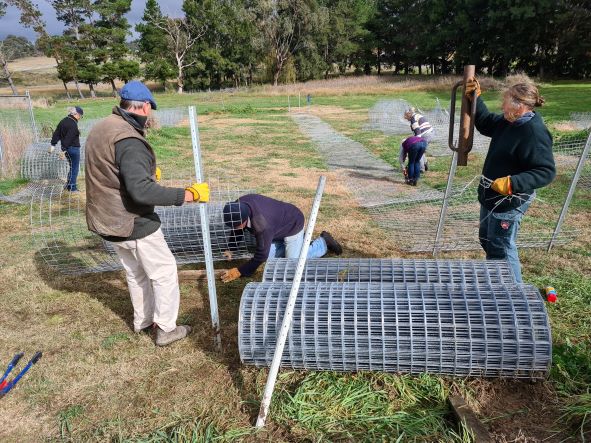
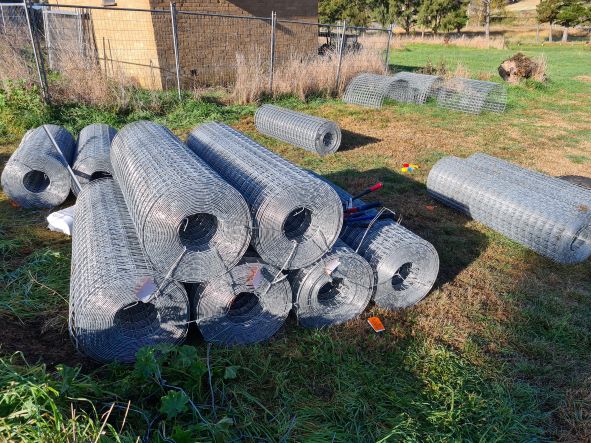
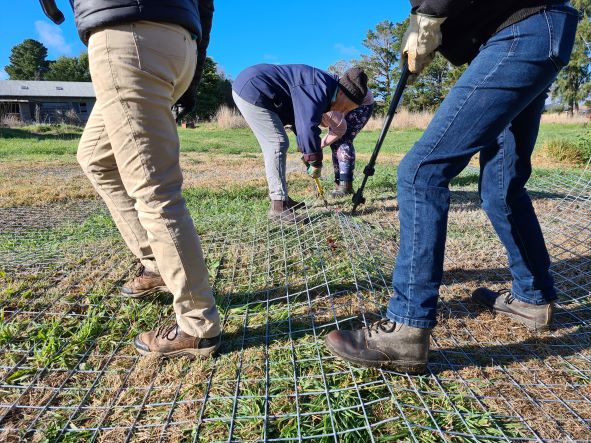
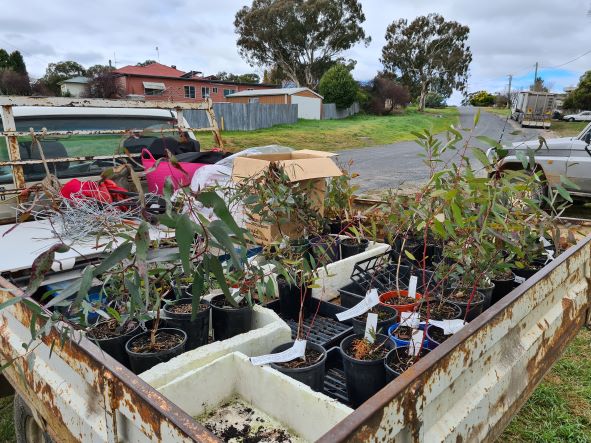

Up close and personal with our little bush friends

Trail cameras are a wonderful way to discover who you are sharing your block of land with – be it feral pests or some of Australia’s unique bird and animal species. However, they’re designed to look at large creatures and give disappointing results on small birds and animals. Moving the camera too close to the target (be it food, or a hole in a fence, or a water bowl) only results in a fuzzy picture as the cameras have a fixed focus that is set for objects a few metres away.
Fortunately, reading glasses work the same way on cameras as they do on people. So, taking one lens from a cheap (less than $10) pair of glasses and attaching it over the camera lens with Blu-Tack is all that’s needed to bring the focus in closer.
Reading glasses come in a range of “strengths”, denoted by the dipotre (D). This is usually printed on the frames or on a small removable sticker. Attached in front of a camera that was originally designed to focus on distant objects, the lens from the reading glasses will place the focal point of the camera at a distance from the camera (in metres) equal to 1/D. So, for commonly available glasses,
D New focus position
+1 1 metre
+2 0.5 metre
+3 33cm
+4 25cm

A few tips
* The cheapest glasses with plastic frames have the lenses glued in place. They are difficult to remove without some violence. For a few dollars more, metal-framed glasses come with lenses that will pop out under strong pressure from a thumb.
* It does not matter if the lens partially covers the infrared illumination LEDs of the camera.
* However, if the lens is too large it might prevent the camera door from opening. The plastic lens can be cut down to size with a small saw such as a Dremel.
* The “depth of field”, or range of distances over which focus is maintained, becomes smaller as the power of the lens increases. A +3 dipotre lens will create a depth of field of only a few cm, requiring careful placement of the camera relative to the subject.

All photos by the author. The small animal pictured above is a yellow-footed antechinus, or mardo (Antechinus flavipes), taken through a +3 lens attached to a Browning trail camera.
John Storey,
Gunning District Landcare
21 Feb 2022
Learning about Aboriginal culture
Over a dozen local children were happily absorbed making bush animals from straw and wool at Gunning Library on Friday 2nd July. Birds, echidnas, goannas, and a sugar glider were just some of the creatures that emerged from the children’s creativity. Ronnie Jordan and her son from Culture on the Move led the activity. Ronnie is a Kalkadoon Pitta Pitta woman who is a professional weaver and artist. She has delivered weaving and art workshops to government agencies, community groups and schools.
Ronnie showed us some of her beautiful weaving, as well as a Coolamon made from Red Stringybark and a digging stick. She also spoke about Aboriginal culture and taught us some Ngunnawal words. We finished the session outside, playing ‘kal-ka-doon kee-an’ – which is based on a traditional Aboriginal game from north Queensland. The version we played involved throwing a tennis ball in a length of stocking, and aiming for target. You can find out more about the game here: https://www.sportaus.gov.au/__data/assets/pdf_file/0003/704847/kalkadoon_kee_an.pdf. The activity was made possible with funding from COORDINARE – South Eastern NSW PHN through the Australia Government’s PHN Program.
This event was part of Gunning District Landcare’s School Holiday Program, which has involved a wide range of fun and educational activities during most school holidays since 2017. The activities are generally held at the Gunning Library, and we are ever grateful to library staff for being so welcoming and friendly (even when the activities create a bit of a mess!). If you would like to join the email list for future activities, please get in touch with Sonya on This email address is being protected from spambots. You need JavaScript enabled to view it. or 0488 027 653.
Mates of Mundoonen: Birds, Bears, Biscuits & Biodiversity
On the cold frosty morning of Sunday 23rd May, a large and enthusiastic group gathered in the Gunning Shire Hall. We were there to learn more about the Mundoonen Nature Reserve and the Mates of Mundoonen Project. We got to hear from four excellent presenters:
- • Ranger Susannah Power from the NSW National Parks and Wildlife Service gave an overview of the history and ecological values of the Mundoonen Nature Reserve, as well as other reserves in the area;
- • Bob Spiller from Gunning District Landcare spoke about the monthly bird surveys that are being conducted in the Mundoonen Reserve this year with the expert help of volunteers from the Canberra Ornithologists Group. Happily, Bob was able to report on a number of sightings of the Spotted Quail-thrush which is a focus of the project;
- • Ecologist Tony Saunders shared his expertise in attracting native birds to local landscapes, including both farms and gardens;
- • ANU researcher Dr Karen Ford, gave a fascinating presentation about koala habitat and feeding ecology, and shared her insights about koalas in our region.
We were also delighted to invite surrounding landholders and community members to join the Mates of Mundoonen Network. This new network aims to increase community understanding of the wildlife and vegetation found in the Mundoonen NR and its surrounds. The more we know about this local treasure, the better will we be able to preserve it for current and future generations.By registering, you will receive: • invitations to upcoming events • opportunities to engage with and learn about the Mundoonen Nature Reserve • koala habitat trees or native shrubsto attract native birds • a Mates of Mundoonen front gate badge for your property. To register, email This email address is being protected from spambots. You need JavaScript enabled to view it. or call Debra on 0477 477 127.
Mates of Mundoonen is a WIRES funded project centred on the MNR and the surrounding district. The project is led by local Landcare groups from the Gunning and Yass districts. Its primary focus is on the koala and Spotted Quail-thrush.Its primary focus is on the koala and Spotted Quail-thrush.These two native animals have been residents of the reserve, but their numbers seem significantly reduced. We want to find out how they are faring – and do all we can to help keep them here for the future.
Stage II: Citizen scientists learn to monitor for Southern Pygmy Perch
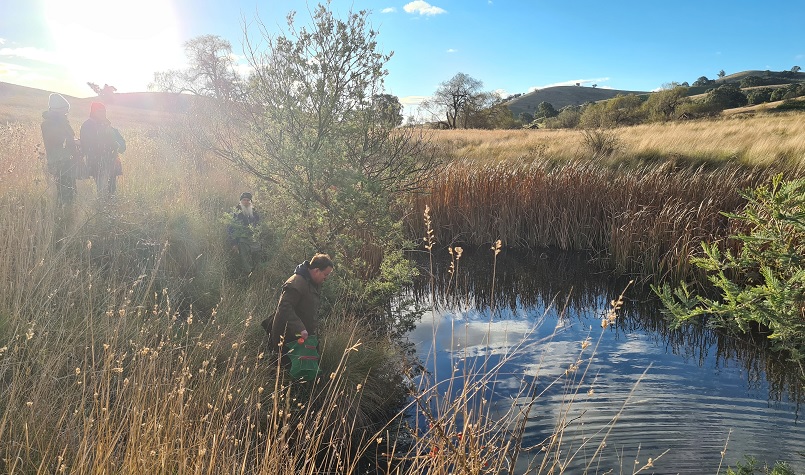
Fungus Discovery Workshop
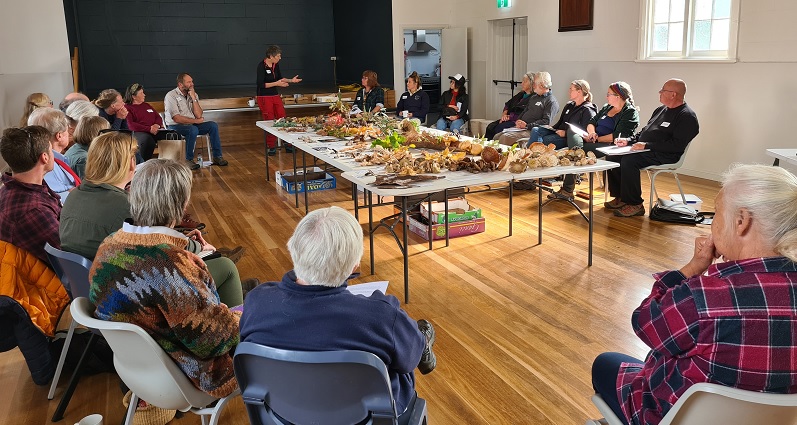
On Sunday 2nd May, Gunning District Landcare hosted a fabulous workshop on fungi in Dalton, led by the amazing Alison Pouliot. Alison shared an enormous amount of information through stories, a beautiful specimen table and a walk in a nearby park. We have all come away with a far greater appreciation of the fascinating and important role that fungi plays in our ecosystems, in our culture, and some invaluable tips on how to approach fungi identification. The next evening, Alison was in Gunning to talk about her new co-authored book, Wild Mushrooming. She again had the audience hanging onto her every word - such is the fascination with fungi and her compelling delivery!
Thanks to everyone who participated and to Local Land Services for providing the funding through a Regional Land Partnerships grant.
Citizen scientists learn to monitor for Southern Pygmy Perch

Trail Camera Photo Competition
Gunning District Landcare is holding an exciting new competition. Anyone can enter, and entry is free!
Take a photo using an automatic trail camera (we’ll lend you one if you don’t have your own), explain in 100 words or less the significance of the photo, and submit it to us by 5pm on Friday 15th October 2021.
A panel of judges will select the best photos for display at the Gunning Arts Festival at the end of October, and the winners will receive cash prizes of $100 each. There’s even a “lucky door” prize – a high quality trail camera!
Please see the competition page here, or download the PDF here.
For more information, including how to borrow a Gunning District Camera trail camera, contact This email address is being protected from spambots. You need JavaScript enabled to view it.
A stellar line-up of Life Members at our 2020 AGM
Gunning District Landcare (GDL) held its Annual General Meeting in Barbour Park on Sunday 15th November. It was a glorious day – sunny, warm and still – the perfect conditions to award Life Membership to John and Jan Weatherstone, and to formally embrace the Life Members of Jerrawa Creek Landcare Group (JCLG), one of the predecessors to GDL.
John and Jan Weatherstone are much loved members of our regional community. They have received widespread acclaim for their innovative management of Lyndfield Park, John’s family property. The shocking effects of drought in the early 1980s marked a turning point on Lyndfield Park, and the beginning of a new journey for the Weatherstones that focussed on revegetation and land regeneration. John was Vice President of Yass River Valley Revegetation Project and a founding member of Jerrawa Creek Landcare Group. The work of John and Jan Weatherstone has inspired many people around Australia to engage with sustainable land management. It is a great honour to include John and Jan as Life Members of GDL.
Mary and John Walsh were the first Life Members of JCLG, awarded in 2008. They were early and enthusiastic adopters of landcare, and their contribution was exceptional and long term. Both were JCLG committee members with Mary being a very effective president. John was particularly knowledgeable about trees and plants.
Jan and Bill Granger were awarded Life Membership of JCLG in 2011. They were founding members and Jan had been a highly valued and long-serving Treasurer, reflected in her nomination for the Westpac Community Treasurer of the Year Award in 2007. Bill was a willing and invaluable contributor to many of the group’s activities.
In 2013, Bob and Rosemary Spiller were also endorsed as Life Members of JCLG for their enormous contribution to the group, including Bob’s role as Secretary for many years. Bob was also awarded Life Membership of Gunning District Landcare in 2017 for his active and effective role in the newly formed group.
Janet Heffernan was awarded life membership of GDL in 2018 in recognition of the significant time and energy that she has put into numerous Landcare activities, most recently the efforts to conserve our local and endangered Southern Pygmy Perch.
To all our Life Members - we thank you for your important role in pioneering Landcare in our region and promoting sustainable land management.
We would also like to thank Deputy Mayor John Searl for helping to officiate our AGM, and the Lions Club of Gunning for a delicious BBQ lunch. The GDL committee looks forward to another year of supporting sustainable land management in the Gunning region.


